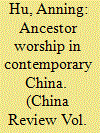|
|
|
Sort Order |
|
|
|
Items / Page
|
|
|
|
|
|
|
| Srl | Item |
| 1 |
ID:
144096


|
|
|
|
|
| Summary/Abstract |
Although ancestor worship has been widely acknowledged as one of the most significant cultural traditions in Chinese society, information about its nationwide popularity and followers’ sociodemographic characteristics is still not clear. Taking advantage of the first nationwide survey on Chinese residents’ spiritual life, this study examines: (1) the extent of popularity of typical ancestor worship practices, (2) the sociodemographic features of ancestor worship individuals, and (3) the “magical” elements of ancestor worship activities. Empirical results suggest that, first, the most popular ancestor worship practices in contemporary China are venerating the spirits of ancestors or deceased relatives and visiting the gravesite of ancestors. Ancestor worship practice participants make up over 70 percent of the adult population. Second, on average, males are more active in ancestor worship than females. Also, economic status is positively associated with ancestor worship participation. Nevertheless, urbanization and migration have a negative effect on people’s propensity of practicing ancestor worship. Third, the magical aspect of ancestor worship is less attractive to well-educated adults, but more likely to be followed by senior individuals.
|
|
|
|
|
|
|
|
|
|
|
|
|
|
|
|
| 2 |
ID:
141112


|
|
|
|
|
| Summary/Abstract |
In this commentary on the research note by Wang Xiaobing, Chengfang Liu, Linxiu Zhang, Yaojiang Shi and Scott Rozelle, “College is a rich, Han, urban, male club: research notes from a census survey of four tier one colleges in China,” I address several caveats in using the relative disparity index in assessing the extent of inequality in access to higher education. Based on these discussions, I point out the potential limitations existing in the empirical study of Wang and colleagues, and reassess the extent of disparity in college education opportunities in contemporary China using data from the 2010 Chinese General Social Survey. Although the descriptive patterns consolidate the study of Wang and colleagues, only household registration status is significantly associated with the likelihood of attending college. These findings indicate that disparities per gender, economic status, and ethnicity based on a limited number of colleges are likely to be subject to sampling errors. Finally, no interaction effects between socio-demographic factors are detected. I offer some reflections on the disproportionality approach in the research of education inequality.
|
|
|
|
|
|
|
|
|
|
|
|
|
|
|
|
|
|
|
|
|